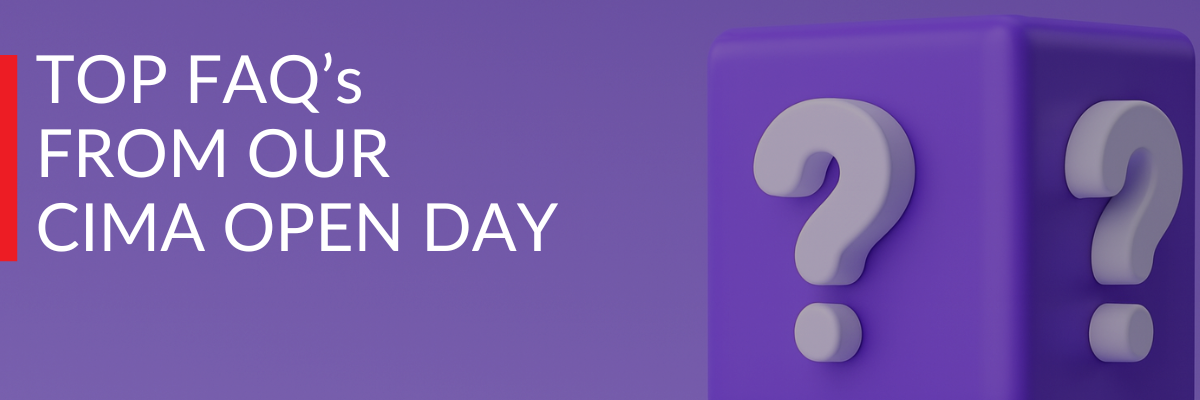(Real questions asked by students during the session)
When we host a CIMA Open Day, one thing is guaranteed: students arrive with real, practical questions about where to start, how exemptions work, and which study route is right for them.
We’ve summarised the most common FAQs asked live during our November Open Day, along with answers to guide your next step.
1. “Which level do I start on with my qualification?”
This was hands-down the most frequently asked question.
Here are the most common examples we received and their estimated starting points:
- BCom Accounting / Accounting Sciences → Management Level
- BCom Financial Management / Economics → Management Level
- BTech Cost & Management Accounting → Operational Level
- National Diploma in Accounting (NQF 6) → Operational Level
- Advanced Diploma in Accounting Science → Operational Level
- Completed SAICA Articles → Strategic Case Study Exam
- SAIPA membership → Management Level
- MBA (Finance-related) → Management Level
- ACCA qualified → Management Level
- 10+ years finance experience → Work Experience 'Elite Pathway'
Not sure where you sit? Email [email protected] and we’ll check your exemptions and entry point for you.
2. “How do exemptions actually work?”
Students asked whether:
- older qualifications still count
- AICA/SAIPA experience contributes
- diplomas qualify
- MBAs grant exemptions
- ACCA gives automatic credit
- graduating more than 7 years ago affects eligibility
CIMA grants exemptions based on completed qualifications, recognised professional memberships, or verified work experience.
The age of your qualification does matter:
- Qualifications older than 7 years are still valid,
- but may result in fewer exemptions than more recent qualifications.
CIMA also provides more exemptions for certain institutions over others, at their discretion.
Use can use the CIMA Exemptions Calculator to check your exemptions.
3. “Is the FLP route better than the Traditional route?”
Many students wanted to know whether they should choose the FLP (Finance Leadership Programme) or the Traditional Professional Qualification (PQ) route.
- “Which one is better for working professionals?”
- “If I already have experience, should I pick FLP?”
- “What’s the cost difference?”
- “Do both routes lead to the same qualification?”
Yes, both routes lead to the exact same CIMA qualification.
FLP Route
- Fast-track option
- Only 3 exams (Case Studies) instead of 16 exams. No Objective Tests.
- Coursework is completed on the FLP online platform
Traditional PQ Route
- 3 Objective Tests exams + 1 Case Study Exam per level
- More exam-focused and structured
- A deeper and more traditional learning approach
Working 8–5 with limited study time? FLP is usually the better fit.
4. “How long does it take to finish CIMA?”
Students wanted timelines for completing the qualification across both routes.
- Traditional PQ Route: ± 3–4 years from Operational Level
- FLP Route: ± 2–3 years (faster due to no OT exams)
- Highly motivated students can finish two levels in one year on FLP.
5. “Can I do CIMA if I’m not from a finance background?”
Yes, absolutely.
If you have no previous accounting or finance qualification, you will start at the Certificate Level. This introductory level has been designed specifically for newcomers entering the finance world.
6. “How do CIMA exams work?”
Students asked about OT exams, pass marks, rewrites, and online exam options.
- OT Exams: shorter, theory-based computer exams for PQ students. Each subject has one OT exam. All OTs in a level must be passed before attempting the level's Case Study Exam.
- Case Study Exams: longer, scenario-based assessments requiring you to apply knowledge from across the syllabus.
- FLP Route: No OT exams, only Case Studies.
- Where do you write?: All CIMA exams are computer-based and can be written online or at any Pearson VUE centre.
- FLP Rewrites: Your FLP subscription includes one exam sitting + one rewrite per level.
7. “Do my SAICA or SAIPA articles count for CIMA PER?”
Yes. SAICA and SAIPA articles counts toward CIMA’s Practical Experience Requirement (PER).
If you’ve already completed articles, you’ve likely met most, if not all, of the PER requirement.
8. “Is there a CIMA to SAICA pathway?”
Students wanted to understand how the two qualifications link.
Yes, a dual-recognition agreement exists between CIMA and SAICA.
- CIMA members (with an undergraduate degree) only need to complete SAICA APC (Board 2) to become a CA(SA).
- SAICA members only need to complete the Strategic Case Study to earn their CIMA designation.
9. “Are IBTC Virtual Classes recorded? Can I watch them later?”
Yes. All IBTC Virtual Classes are recorded, allowing you to rewatch sessions or catch up after work.
These FAQs capture what students genuinely want to know before starting their CIMA journey. Whether you're switching careers or moving from SAICA to CIMA, the key is understanding your entry level, your exemptions, and which study route fits your lifestyle best.
Need help confirming your starting point? Complete the form below and our team will reach out to assist you.






